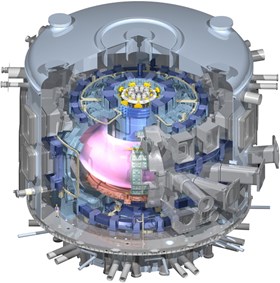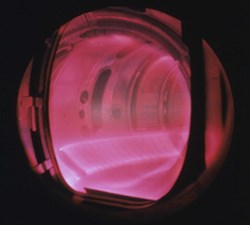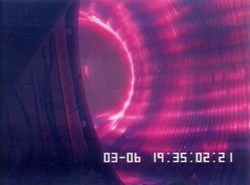
Hydrogen, helium with up to 5% hydrogen, then deuterium, and eventually the ''actual fusion fuels,'' deuterium and tritium in equal proportion. On its way to full deuterium-tritium operation, ITER will experiment with a succession of plasma fuels.
On its way to full deuterium-tritium operation, ITER will experiment with a succession of "non-nuclear" plasma fuels.
Spread over a period of roughly seven years, hydrogen, helium (with a variable proportion of hydrogen) and deuterium campaigns—interspersed with maintenance and upgrade periods—will provide operators with the necessary know-how to run the machine, commission its components, and control its plasma before entering nuclear operation.
Neither hydrogen nor helium will "activate" the machine, allowing manned access into the vacuum vessel until deuterium operations begin in late 2026 or early 2027.
First Plasma, scheduled in November 2020, will use hydrogen. "It is presently defined as a 'minimal plasma' of a few-hundred-milliseconds duration with approximately 100 kAmps of current intensity," explains David Campbell, Director of the ITER Directorate for Plasma Operation.
This inaugural plasma will be run in a rather "bare" machine: no divertor or shielding blankets will have yet been installed. "We will just have poloidally distributed structures to protect the diagnostic systems and other elements on the vacuum vessel inner wall," says David.
First Plasma will be followed by a one-month-long campaign of short-duration plasma pulses (perhaps several seconds in length), during which the goal will be to increase the current intensity progressively to one to two MAmps.

A plasma in TEXTOR (Tokamak Experiment for Technology Oriented Research) operating at Forschungszentrum Jülich, Germany.
By March 2023, ITER will be ready to begin its experimental program, based initially on running hydrogen or helium plasmas. The "non-active" campaign will last about three years. As plasmas are created at a rate of twenty to thirty per day, systems will be tested, operators trained and more components commissioned.
Why helium? The reason lies in the mysteries of the
H-mode (H for High), the sudden improvement of plasma confinement and the disappearance of edge turbulence that occurs in toroidal configurations. While all tokamaks today are designed to operate in H-mode, the understanding of the physics behind the phenomenon is still incomplete.
"We want to know what an H-mode plasma looks like at the ITER scale," explains David. "And we want H-mode in order to get
ELMs and demonstrate that we can control them."
For reasons that are complex and not fully understood, it requires less heating power to get into H-mode with helium than it does with hydrogen. As not all heating systems will be operational when ITER enters its experimental program, helium is a good compromise.
"Ideally, we would have used hydrogen, but with only 60MW of heating power installed at that stage, creating H-modes in hydrogen would be marginal. Helium is not ideal but it should allow us to demonstrate ELM control."

In 2002, the CEA-Euratom Tokamak Tore Supra, located in Cadarache, achieved a record 6.5-minute-long deuterium plasma discharge.
Helium plasmas (with a small percentage of hydrogen) will also make it easier to commission the Ion Cyclotron Radiofrequency (ICRF) heating system. "Ion cyclotron waves are not absorbed very well in pure hydrogen plasmas," says David. "When you use helium and a minority of hydrogen, up to 5 percent, you get much better results..."
By early 2026 the hydrogen, helium and "minority hydrogen" phases will be complete, and most components installed and commissioned. ITER will be ready for the transition to nuclear operation.
This transition will require a pre-nuclear shutdown—lasting about nine months, this will be the last opportunity for performing manned operations inside the machine, fixing what must be fixed and installing new components if needed.
In the deuterium-only (DD) phase that will follow, fusion reactions in the plasmas will be sufficiently numerous to begin activating the inner components of the vacuum vessel. The DD plasmas will closely mimic many aspects of the behaviour of the next-stage deuterium-tritium (DT) plasmas, including H-mode.
"Toward the end of 2027, we should be able to feed trace amounts of tritium into the plasma," explains David. "The first significant flux of high energy (14 MeV) neutrons will be produced, giving us important indications on how tritium propagates into the plasma."
"Q" symbolizes the ratio of fusion power to input power. "Q ≥ 10," which is ITER's objective, means that the burning plasma will generate at least ten times more power than will be needed to "ignite" it. In JET and the US tokamak TFTR, Q remained under 1. ITER will be the first fusion experiment to produce net energy.
As the proportion of tritium is progressively increased, more fusion power will be produced. "Within four to six months, we aim to be able to demonstrate Q=10 for several tens of seconds. This, however, is not yet the full mission goal: we will need time to learn how to handle long pulses in order to achieve the project's objective of sustaining Q=10 for periods of 300 to 500 seconds."
At this point, following a scheduled shutdown in mid-2028, ITER, in accordance with the ITER Licence will still have about ten years of planned experimental activity ahead—time enough to develop even longer pulses (up to 3,000 seconds); explore the possibility of higher Q plasmas; and, among several other challenges, develop plasma regimes using DEMO-relevant components and concepts.
The project's lifespan, however, could be extended beyond 2037: "Obviously," says David, "if the Members agree on the continued usefulness of the ITER device beyond its mission goals—and if the French Safety Authority gives a green light—it may be decided, at some point, to extend the Operations Phase."
Such things happen—
JET, after all was scheduled to close in ... 1990.
Click here to view a plasma discharge in the European tokamak JET, now equipped with an ITER-like wall.




